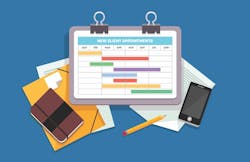OK, let’s start with this premise: No one is perfect. This goes for every aspect in life, but for the sake of this column, we might as well just limit the conversation to all of us running our shops. And, boy, I had a nice, humbling reminder of that just a couple weeks ago.
I was just wrapping up one of the most tiring but personally satisfying weeks of my life. I presented roughly 15 times over the course of a week to about 150 shop owners—broken up into two groups. In one of my last sessions, we discussed the connection between call count and car count. I like breaking down numbers, so that’s how I started things off: Looking at one of my shops, we saw that the location received about 3,500 calls per month. Dig deeper, and about half of those were inbound calls about appointments and service. (The other half is a mixture of calls with parts vendors, callbacks to and from customers, additional sales calls, etc.) So, at the end of the day, you could say about 1,200–1,500 calls per month were opportunities for our shop to gain work.
And here’s the final important number: Of those, about 275–300 became customers.
Now, that number’s not the humbling part of this story. That’s a pretty similar number across all my shops. I brought in those numbers to make a point: If we just focused on improving our work on the phones and capitalize just a smidge more, how much would that affect our car count and revenue? The answer is a lot. A whole lot. So, to push the point further, we picked some shops in the audience and starting call their shops on speaker phone, me acting as potential customer Bob Smith with an issue on my truck.
The results ranged a bit—from extremely impressive to wildly entertaining.
One shop owner in attendance, his guy at the counter had the answer at every turn. He absolutely nailed it; picture-perfect call. Every time I asked for a price or tried to get him to mess up, he stuck to a great approach. He asked my name at the beginning—first and last—and he asked me for my phone number in case we got disconnected and he needed to call me back. He repeated my name naturally throughout the conversation. He thanked me for my call. I’ll get into some phone tips in my next column, but this guy had it all down. It was really, really impressive, and this was a small shop where the counter was flooded with work and calls.
There was another shop I called where the service advisor recognized it was me and gave some of the good-natured ribbing right back to me. It had the room in hysterics, but it also served as a great example of someone with a great mindset at the front counter: He approached every call and interaction as a challenge, and his competitive nature made him focus and stay on task. It’s an important aspect if, say, you have competitors that may call from time to time to fish out information about how you operate. Hint: There’s no need to deceptively call competition. If you ever want to understand a competitor’s status, simply get two oil changes there a week apart. The difference in the two RO numbers will tell you how many vehicles they service each week, and you can figure out the rest.
But, really, why waste the time checking on competitors? Maybe we should check on our own shops? Well, that’s what I did to close out this session.
I called one of my shops. No one answered.
I called again. No one answered.
I called a different shop, and a new employee answered. She gave me our labor rate over the phone.
I called another one of my shops. I got a range for the labor rate and the complete price of a brake job.
Not good. I was embarrassed.
I push and push with my teams to keep training and still, those were the very real results of those test calls.
This isn’t anything against my team. This is on me, and it’s on all of us whenever things like this can happen. Our teams will fail to the highest level of preparation. If we don’t see that and focus on that at every moment, it will cost us big. The most costly mistake is that the car never shows up, not that the car shows up and we sold it wrong.
Think back to those numbers, and don’t you think we can add 10 percent to the number of jobs sold just by focusing on improving our phone skills? The first impression on the phone is the most important interaction we have with customers. We can’t fail at that.
My team’s going to train harder and focus more. While we won’t ever be perfect, we can always get better.
About the Author

Aaron Stokes
A nearly 20-year veteran of the automotive repair industry, Aaron Stokes grew his business, AutoFix, from a one-car garage to a six-shop operation that is widely regarded as one of the top repair businesses in the country. Stokes, the founder of Shop Fix Academy, is an operational guru with a unique business and leadership philosophy that has led his business to great heights.
